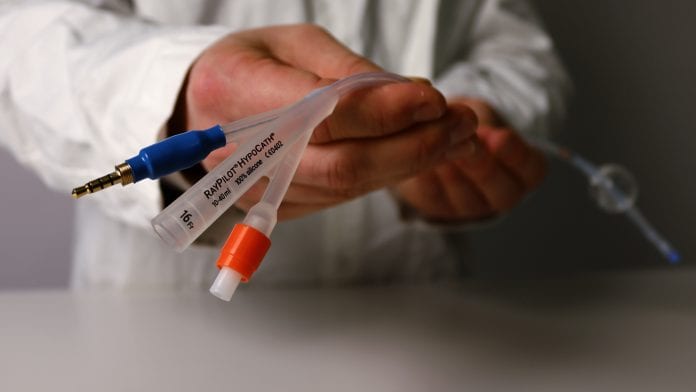
Swedish company Micropos Medical has developed a novel system to make prostate cancer treatment faster, safer and more targeted.
Micropos Medical is a Swedish company based in Gothenburg, which has developed, produced and certified the RayPilot system as an accessory for linear accelerators to increase the precision and efficiency of radiation treatment of prostate cancer. The idea for RayPilot came from an international team of doctors and professors in oncology with experience in radiation therapy.
With the establishment of hypofractionation, whereby radiation is delivered in higher doses over shorter periods of time than conventional radiotherapy, the company has developed HypoCath. This is a catheter with a built-in transmitter, which completely eliminates the surgical procedure that has been identified as a major obstacle in the daily workflow.
Radiation therapy: finding the balance between effect and side effect
Today, the radiation treatment process for a number of cancers means that each patient must come to the hospital daily for treatment over a period of seven to 10 weeks. In each individual session, it is of the utmost importance to target the tumour precisely during the delivery of radiation in order to cure the patient. One problem with this, however, is that internal organs – and by extension the tumour – can move completely unpredictably both during and between the treatment sessions. The prostate, for example, can move by more than 1.5cm during radiation treatment. This movement cannot be routinely detected, leading to the irradiation of a much larger area than the cancerous tumour itself. The patient is thus exposed to a significant risk side effects, which can substantially reduce their quality of life. For a prostate cancer patient, this can mean impotence, urinary tract problems and bleeding from the rectum for the rest of their lives, while also reducing their chance of being cured.
RayPilot: a binocular sight for increased accuracy
RayPilot can be compared to a GPS system, which accurately indicates the position of the tumour in relation to the radiation field during treatment with heightened precision. Patient safety is improved by focusing the radiation on the tumour and reducing the dose applied to the surrounding healthy tissue. In prostate cancer treatment, this reduces the risk of undesired side effects.
The increased accuracy means that RayPilot can be used to enable safer application of hypofractionation, which is now becoming more established in the treatment of a number of cancers and which can reduce the number of treatment sessions needed from between 30 and 40 to fewer than 10. According to a study presented in 2017 at the annual meeting of the American Society for Radiation Oncology (ASTRO), the world’s largest radiation therapy congress, RayPilot is a reliable system which can be quickly implemented in clinical practice. The new HypoCath product radically facilitates the use of the system and fits neatly into standard daily workflow.
Treating prostate cancer
Prostate cancer is usually treated with radiation therapy or surgery. Both methods have similar results, but radiation therapy is more cost effective. Around 25% of all patients diagnosed with prostate cancer are treated with radiation therapy at some point during the course of the disease. In addition, 20% of all prostate cancer patients who receive surgery will need postoperative radiation therapy. However, there is a shortage of radiation treatment capacity in many parts of the world, which is becoming a growing problem as the number of cancer cases increases. Clinics can increase their capacity for prostate cancer treatment through an increase in staff, with a simultaneous transition to shift work, or through the purchase of more linear accelerators. Another, cheaper way is to increase treatment capacity via the transition to hypofractionation.
Hypofractionation means that the total desired radiation dose is given at fewer treatments. At the same time, this significantly increases the risk of incorrect treatment if, for example, organ movement occurs during treatment. RayPilot is therefore an important tool for handling organ movement and precision and thereby achieving better accuracy. After Helsinki University Hospital became the first customer of Micropos to use RayPilot for selected prostate cancer patients who were treated on five occasions against the normal 30 or so, more clinics have now begun to take advantage of the increased precision and take the step towards hypofractionation.
RayPilot contributes to an increase in capacity of up to eight times, reduced risk of side effects and a shorter and smoother treatment for patients. In 2020, the Edinburgh Cancer Centre in collaboration with Liverpool University presented a study highlighting the importance of monitoring prostate movement in connection with high-dose radiation therapy. Micropos’s partner clinic at San Gerardo Hospital in Monza, Italy, led by Professor Stefano Arcangeli, has also shown the importance of being able to monitor organ movement; and has described how this can be done within the framework of daily clinical routines.
Clinics in Europe have begun to take advantage of the increased precision that the RayPilot system provides, both to reduce the number of treatment sessions and to ensure that radiation is given to the tumour while minimising the risk of damaging the healthy surrounding tissue. Following the introduction of HypoCath in 2019, several clinics in Germany have already invested in the RayPilot system.
Please visit our homepage for more information or to book a demonstration.
Thomas Lindstrom
Micropos Medical AB (publ)
thomas.lindstrom@micropos.se
www.micropos.se






















